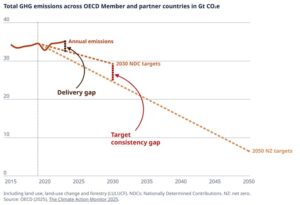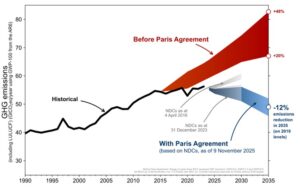Cities pass peak emissions, inaction to hit revenues and heat-as-a-service
In this issue:
Cities pass peak emissions
C40 is a global network of mayors working to reduce emissions in their cities. There are currently 97 cities involved with a total population covered of 920 million. Auckland is New Zealand’s only participant. C40 has just published a survey of participants claiming 60 of the cities have passed peak emissions. Stockholm and Copenhagen have seen the greatest post-peak falls with both at over 40% down from peak. Another nine cities sit in the 30%-40% band, including Athens, London, Milan, Paris, Salvador, San Francisco, Sydney, Washington and Yokohama. The report concludes that while progress has been good, much remains to be done to keep below the 1.5C threshold.
Poor international progress on emissions reduction
The recently published OECD Climate Action Monitor reports poor progress on reducing emissions across its 52 members. Climate action expanded only 1% in 2024, continuing the slowdown observed since 2021. Only 30 OECD countries (representing less than 18% of global emissions) have legally binding net-zero targets. To constrain warming to 1.5C above pre-industrial levels will require a 63% reduction of emissions from OECD countries by 2035.
Paris is working – at least partially
To coincide with the kick off of COP30 and following a flurry of submissions, the UN has just published its latest synthesis of where NDCs will take us, concluding the Paris agreement has delivered strong results even if projections suggest there is still a lot to do. The nub of the synthesis is that, based on NDCs, we should expect to see global emissions in 2035 at 12% below 2019 levels. It goes on to conclude without the Paris Agreement, emissions would be between 20% and 48% up on 2019.
Climate inaction to cut revenues 15%
That’s the conclusion of a survey of 850 businesses across 50 countries by EY. Its Climate Action Barometer indicates while over 90% of companies assess the potential impact of physical climate risks, only 44% have started looking at adaptation measures. Only a third are looking at the possible financial impact of both the cost of action and the long-term cost of inaction. Those that are looking at the potential cost of inaction are foreseeing a 15% drop in revenue if they do nothing.
Climate transition planning paying dividends
Analysis by CDP indicates institutional investors are increasingly looking to see climate transition plans when undertaking their due diligence. Transition plans carry obvious risk mitigation benefits in the medium and long term but the research suggests companies with robust transition plans are nearly twice as likely to identify short term opportunities for growth and cost savings.
Heat-as-a-service powers Portuguese brewery
Heineken’s Vialonga brewery near Lisbon is to switch to renewables using an innovative, brick-based heat battery and service contract for the steam it needs for the plant. The arrangement is a partnership between Heineken, EDP Commercial and Rondo Energy. Rondo provides the battery technology, EDPC will design, build and run the system and provide the steam to Heineken under a service contract. An onsite solar plant of 7MW, combined with renewable electricity from the grid will be stored in the heat battery, which will have a capacity of 100MWh and provide 24-hour steam.
Did you know …..
Across COPs 26-29 (inclusive), over 5,350 fossil-fuel lobbyists were in attendance? Unsurprisingly, COP28 in the UAE saw most fossil-fuel attendees at 2,456. Over the years, 859 different organisations were represented, of which 180 were oil and gas companies.


